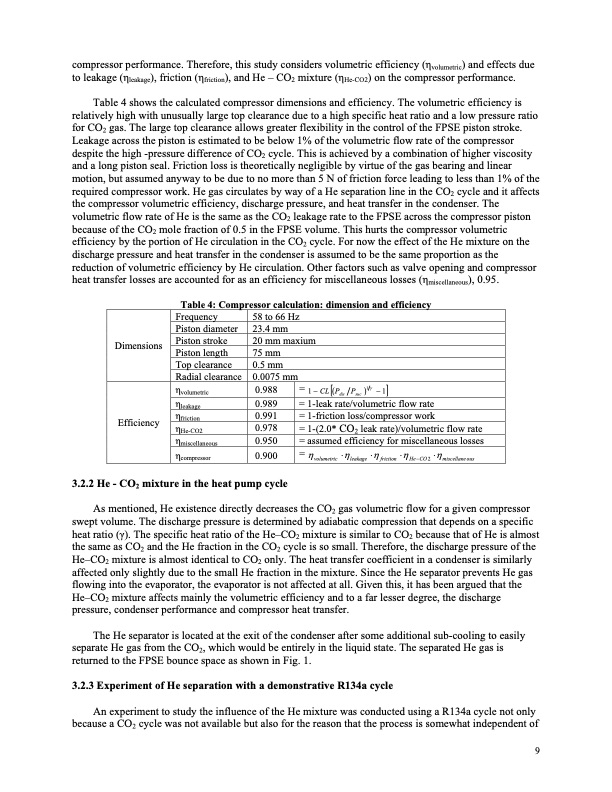
PDF Publication Title:
Text from PDF Page: 009
compressor performance. Therefore, this study considers volumetric efficiency (ηvolumetric) and effects due to leakage (ηleakage), friction (ηfriction), and He – CO2 mixture (ηHe-CO2) on the compressor performance. Table 4 shows the calculated compressor dimensions and efficiency. The volumetric efficiency is relatively high with unusually large top clearance due to a high specific heat ratio and a low pressure ratio for CO2 gas. The large top clearance allows greater flexibility in the control of the FPSE piston stroke. Leakage across the piston is estimated to be below 1% of the volumetric flow rate of the compressor despite the high -pressure difference of CO2 cycle. This is achieved by a combination of higher viscosity and a long piston seal. Friction loss is theoretically negligible by virtue of the gas bearing and linear motion, but assumed anyway to be due to no more than 5 N of friction force leading to less than 1% of the required compressor work. He gas circulates by way of a He separation line in the CO2 cycle and it affects the compressor volumetric efficiency, discharge pressure, and heat transfer in the condenser. The volumetric flow rate of He is the same as the CO2 leakage rate to the FPSE across the compressor piston because of the CO2 mole fraction of 0.5 in the FPSE volume. This hurts the compressor volumetric efficiency by the portion of He circulation in the CO2 cycle. For now the effect of the He mixture on the discharge pressure and heat transfer in the condenser is assumed to be the same proportion as the reduction of volumetric efficiency by He circulation. Other factors such as valve opening and compressor heat transfer losses are accounted for as an efficiency for miscellaneous losses (ηmiscellaneous), 0.95. Table 4: Compressor calculation: dimension and efficiency Frequency Piston diameter Piston stroke Piston length Top clearance Radial clearance η volumetric As mentioned, He existence directly decreases the CO2 gas volumetric flow for a given compressor swept volume. The discharge pressure is determined by adiabatic compression that depends on a specific heat ratio (γ). The specific heat ratio of the He–CO2 mixture is similar to CO2 because that of He is almost the same as CO2 and the He fraction in the CO2 cycle is so small. Therefore, the discharge pressure of the He–CO2 mixture is almost identical to CO2 only. The heat transfer coefficient in a condenser is similarly affected only slightly due to the small He fraction in the mixture. Since the He separator prevents He gas flowing into the evaporator, the evaporator is not affected at all. Given this, it has been argued that the He–CO2 mixture affects mainly the volumetric efficiency and to a far lesser degree, the discharge pressure, condenser performance and compressor heat transfer. The He separator is located at the exit of the condenser after some additional sub-cooling to easily separate He gas from the CO2, which would be entirely in the liquid state. The separated He gas is returned to the FPSE bounce space as shown in Fig. 1. 3.2.3 Experiment of He separation with a demonstrative R134a cycle An experiment to study the influence of the He mixture was conducted using a R134a cycle not only because a CO2 cycle was not available but also for the reason that the process is somewhat independent of Dimensions Efficiency ηleakage ηfriction ηHe-CO2 ηmiscellaneous ηcompressor 58to66Hz 23.4 mm 20 mm maxium 75 mm 0.5 mm 0.0075 mm 0.988 =1−CL[(P P )1γ −1] dis suc 0.989 = 1-leak rate/volumetric flow rate 0.991 = 1-friction loss/compressor work 0.978 = 1-(2.0* CO2 leak rate)/volumetric flow rate 0.950 = assumed efficiency for miscellaneous losses 0.900 = ηvolumetric ⋅ηleakage ⋅ηfriction ⋅ηHe−CO2 ⋅ηmiscellaneous 3.2.2 He - CO2 mixture in the heat pump cycle 9PDF Image | HERMETIC GAS FIRED RESIDENTIAL HEAT PUMP

PDF Search Title:
HERMETIC GAS FIRED RESIDENTIAL HEAT PUMPOriginal File Name Searched:
Gas_Fired_Heat_Pump.pdfDIY PDF Search: Google It | Yahoo | Bing
CO2 Organic Rankine Cycle Experimenter Platform The supercritical CO2 phase change system is both a heat pump and organic rankine cycle which can be used for those purposes and as a supercritical extractor for advanced subcritical and supercritical extraction technology. Uses include producing nanoparticles, precious metal CO2 extraction, lithium battery recycling, and other applications... More Info
Heat Pumps CO2 ORC Heat Pump System Platform More Info
| CONTACT TEL: 608-238-6001 Email: greg@infinityturbine.com | RSS | AMP |